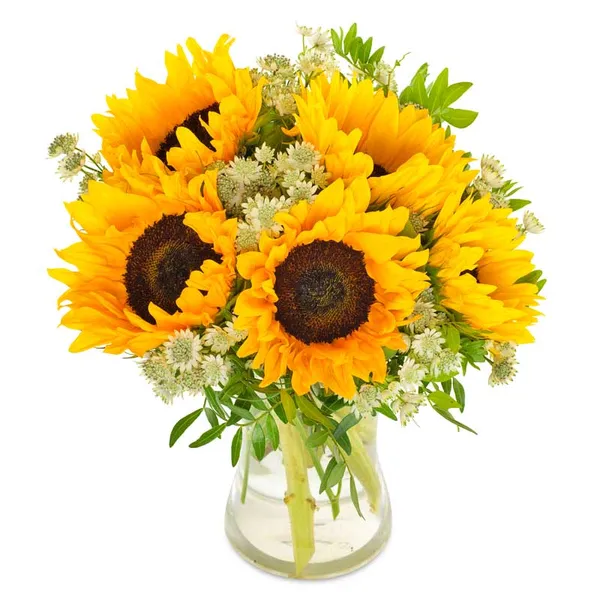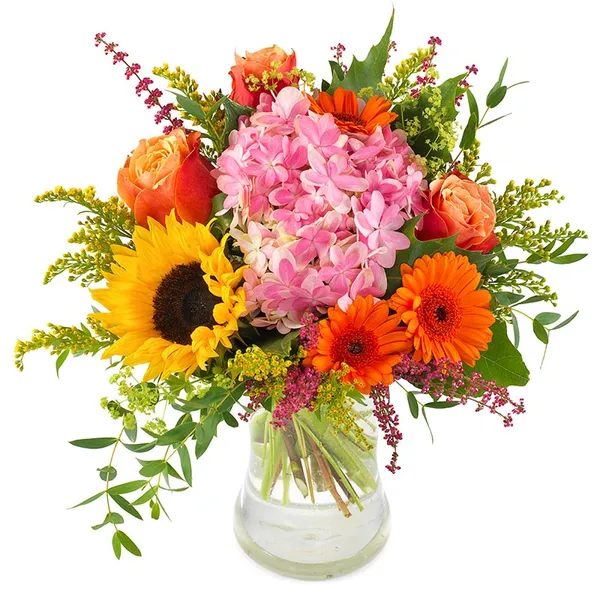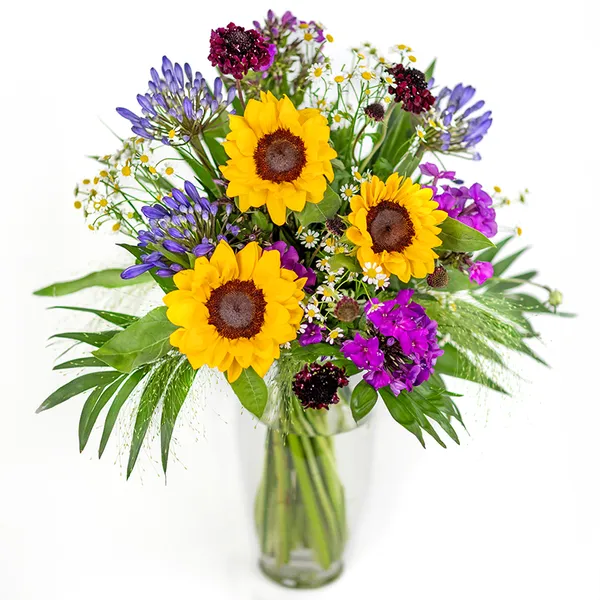Sunflower: The Radiant Flower of Joy
The sunflower is one of the most iconic and beloved flowers in the world. With its large, bright yellow petals and dark centre, it symbolises happiness, optimism, and warmth. Sunflowers are known for their unique ability to follow the sun throughout the day – a behaviour called heliotropism. Originally native to North and Central America, they were cultivated by indigenous cultures long before becoming a global favourite. Beyond their beauty, sunflowers are also practical: their seeds are edible, pressed into oil, or used as bird feed, making them both decorative and functional.
COMMON NAME
Sunflower
BOTANICAL NAME
Helianthus annuus
ORIGIN
North and Central America
PEOPLE ALSO CALL IT
Sunwheel, Flower of the Sun
FLOWERING TIME
Summer to early autumn (July to September)
ASPECT
Full sun
SYMBOLISM
Joy, strength, optimism, loyalty
Care Tips for Cut Sunflowers in a Vase
Trim the stems: Cut stems at an angle with a sharp knife to improve water intake.
Remove lower leaves: Strip off any leaves that will sit below the waterline to prevent rot.
Change water regularly: Replace the water every 2-3 days and clean the vase to prevent bacterial growth.
Use flower food: Add floral preservative to prolong freshness and support the blooms.
Keep cool: Place sunflowers in a bright but not too warm spot – excess heat can cause them to wilt faster.
Care Tips for Potted Sunflowers
Light requirements: Sunflowers need plenty of direct sunlight – place them somewhere they get at least 6-8 hours a day.
Watering: Keep the soil evenly moist but not soggy. Ensure good drainage to avoid root rot.
Soil: Use nutrient-rich, well-draining potting mix.
Fertilising: Feed once a week with a liquid fertiliser designed for flowering plants.
Support: Taller varieties may need staking to stay upright during wind or rain.
Symbolism & Meaning
Sunflowers are the ultimate symbol of joy, positivity, and hope. Their bright, sunny appearance brings cheer wherever they go, making them perfect for uplifting someone's mood or offering comfort. Sunflowers also symbolise loyalty and strength, as they turn toward the light and stand tall, even in harsh conditions. In many cultures, they are considered lucky charms and are associated with abundance and prosperity.
Types of Sunflowers
There are countless varieties of sunflowers, differing in height, bloom size, and colour. The classic Helianthus annuus grows up to three metres tall with large, golden-yellow heads. Dwarf sunflowers like ‘Teddy Bear’ are compact and perfect for balconies or pots. Some varieties, such as ‘Moulin Rouge’ or ‘Velvet Queen’, produce deep red or burgundy flowers, offering a dramatic twist on the traditional sunflower. Whether tall or small, yellow or dark red – sunflowers always bring a little sunshine with them. 🌻
Frequently Asked Questions About Sunflowers
No, sunflowers are non-toxic to cats. According to the ASPCA and veterinary sources, sunflowers are safe for cats. However, if a cat chews on the leaves or flowers, it might experience mild digestive upset like vomiting or diarrhea, but this is not due to toxins, just irritation.
No, sunflowers are also non-toxic to dogs. Like with cats, ingestion might cause mild stomach upset, but they are generally considered safe. Still, avoid letting pets chew on garden plants to prevent unnecessary tummy troubles.
Sunflowers should be planted from mid-April to early June, depending on your location and last frost date.
The soil temperature should be at least 10°C. In colder areas, wait until late spring.
You can start seeds indoors in April and transplant them outside after the frost, or direct sow them into the ground once the weather is consistently warm.
Sunflowers symbolize positivity, loyalty, admiration, and happiness. They are often associated with the sun, warmth, and good energy. In many cultures, they also represent gratitude and long life, and they are often used to cheer people up or celebrate new beginnings.
Sunflowers typically bloom from July to September, depending on when they are planted and the variety.
Some early varieties bloom in as little as 60 days, while tall or branching types may take up to 90-100 days to flower.
Most common sunflowers (Helianthus annuus) are annuals, meaning they complete their life cycle in one season.
However, some perennial sunflower species exist, such as Helianthus maximiliani or Helianthus tuberosus (Jerusalem artichoke), which come back year after year.
Choose a sunny spot: Sunflowers need 6-8 hours of direct sunlight daily.
Soil: They prefer well-draining soil, ideally enriched with compost.
Planting depth: Sow seeds about 2-3 cm deep, spacing them 20-45 cm apart, depending on the variety.
Watering: Keep the soil moist during germination. Once established, sunflowers are drought-tolerant but benefit from regular watering.
Support: Tall varieties may need staking, especially in windy areas.
Yes, deer do eat sunflowers. They are especially attracted to the young leaves and flower buds. If deer are common in your area, consider using fencing, netting, or natural repellents to protect your plants.
Sunflowers take about 70-100 days from seed to bloom, depending on the variety:
-
Dwarf and early varieties: 60-70 days.
-
Large and branching types: 80-100 days.
For seeds (e.g. for eating or replanting):
-
Wait until the flower head browns and seeds loosen easily.
-
Cut the head off and hang it upside down in a dry, airy space.
-
Once fully dry, rub seeds out by hand and store them in a cool, dry place.
For decorative drying (whole flower heads):
-
Cut the flower before it's fully mature, while petals are fresh.
-
Hang upside down in a dark, dry, well-ventilated room for 2–3 weeks.
-
Optional: Spray with hairspray or floral fixative to preserve color and shape.




